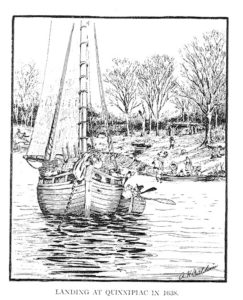
West Haven’s Earliest Days
Part I
See part 2 here.
See part 3 here.
See part 4 here.
See part 5 here.
We acknowledge the efforts of Lorraine Wood Rockefeller, who originally set these words down in about 1960.
Our town, now thickly settled, thriving and busy, centers around the Green in traditional Yankee style. The Green is a heritage for future generations, a reminder of the forbears who built West Haven, once just “common land.”
Early West Haven’s history is intermingled with that of New Haven, a part of that town until 1822. Then, with North Milford it was incorporated as the Town of Orange. Not until 1921 was West Haven established as a separate town.
New Haven was settled in 1638 by a company of some 300 English emigrants led by the Rev. John Davenport and Theophilius Eaton with the intention of “founding a commercial colony to be governed by the laws of the Bible.”
Leaving England in April of 1637, they landed in Boston and investigated the advantages of Quinnipiac (the Indian name for the territory of which New Haven is now the center). A committee was sent to confer with its Indian owners. Finding the lands quite satisfactory, they settled in Quinnipiac, the price paid English and French cutlery, hatchets, knives, scissors and 13 coats. The Indians were few in number and were glad the English had come as they would protect them from their enemies, the Pequots and the Mohawks.
The treaties were made, purchasing their land in and around the place, leaving them reservations for raising corn, beans, pumpkins, squashes and the right to hunt, fish and go oystering and clamming to their hearts’ content.
Davenport preached his first sermon Aug. 22, 1639, under a large oak tree near what is now the corner of George and College Streets, New Haven. Seven men were chosen and called “the seven pillars of the church.” Davenport’s Company, which had come from London in the Hector and her consort, had as their object to found, untrammeled, a Christian Commonwealth.
John Beecher, one of the seven men who spent the first winter, died. They spent the winter in a hut near West Creek.
Some of the first settlers dwelt in halfway caves as temporary lodgings. Rev. Michael Wigglesworth who came to Quinnipiac with his parents in Oct. 1638, when he was about seven years old, wrote “Winter approaching we dwelt in a cellar, partly underground, covered with earth, the first Winter. But I remember that one great rain brake in upon us and drench me so in my bed, being asleep, that I fell sick upon it, but ye Lord in mercy spar’d my life and restored my health.”
To Be Continued-